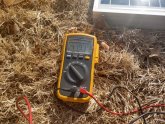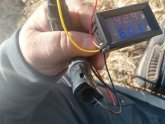TheeBigGuy
New Member
- Joined
- Oct 1, 2019
- Messages
- 50
I bought a couple used panels cheap!!.. With a clamp amp meter they tested late in the day about 20% below spec... How should they be tested to make sure all cells are working?


Plug the DC Voltmeter directly into the ends on the panel. Aim the panel as best you can to a right angle to the sun, as close to high noon as you can get.
This will give you the VOC at that particular time and date. If the number showing is within 10~15% of the rated panel, you are good to go. Temperature also makes a big difference.
"Standard Conditions" are 1000 w/m2 lux and 25°C. The colder the higher the volts, the hotter the lower the volts.
View attachment 6127 View attachment 6128
Don't look at the sun! Make a quadrant (print the file and get a straw+string, or read the instructions and use a straw)
[/QUOTE
Thank you... I guess I need to restate my question..I bought used panels and one of them ended up peaking at 6.7amps.. 365 watt 9.2 amp panel...After putting it on a load one section of the panel is not working... Is there a way to test each section of a used panel so I don't make the same mistake? thanks
Good idea.Actually, you can...
But you need an infrared camera...
power the panel, and look at each cell, they should glow equally...
A phone that shoots infrared or an app that simulates infrared.. If so what app worked for you?..thanksI use the phone one works great.
I will repeat someone's previous tip to point the panel at the sun, put a 3D block (like short piece of 2x4) on the panel and aim the panel so there is no shadow on any side of the block. Great trick for good aim.

After "checking" a shadow. By far the quickest and easiest way to cast a shadow to get the "noon" angle, is with a tool you can't loose or forget.Or even a small short plunger with wooden dowel stuck to the middle of the panel pointed til no shadow as mentioned in many aiming posts here over time. ?


